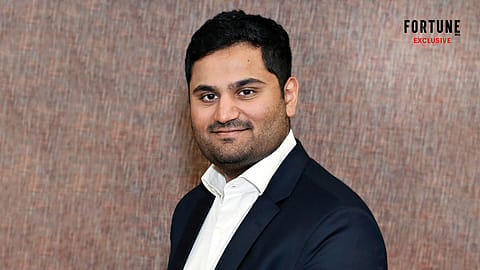Exclusive: Adani Group is actively exploring opportunities in upcoming rounds of airport privatisation by AAI, says Jeet Adani
Adani Group plans to double air passenger capacity at its airports, says Adani Airport Holdings Limited's director Jeet Adani.

The Adani Group is all set to start commercial operations at the greenfield Navi Mumbai International Airport at Panvel later this year. It will have an initial passenger capacity of 20 million, projected to become 90 million on completion in phases, which will give the Adani Group a share of 35% in India’s airport passenger traffic. Already, Adani airports handled a record 94 million passengers in FY25. Jeet Adani, director of Adani Airport Holdings Limited (AAHL), a subsidiary of the group's flagship Adani Enterprises, talks about the advantages of the new airport and growth plans, besides his other responsibilities in the group, like data centres and the super app in an interview with Fortune India. Edited excerpts:
With the Navi Mumbai International Airport readying for take-off, what change will it bring to India's air travel?
The Navi Mumbai International Airport (NMIA) is set to redefine Indian aviation. By easing the burden on Mumbai’s existing airport, it will significantly enhance connectivity across the Mumbai Metropolitan Region (MMR). Designed with India’s ambition of becoming a global aviation hub in mind, NMIA will elevate the passenger experience and serve as a vital link between local and international travel. It’s a forward-looking infrastructure project that aligns with both regional growth and global aspirations.
How challenging was it for you to meet the massive infrastructure development schedule, especially for a large greenfield airport?
Delivering this airport has been a monumental task. Our team and stakeholders have truly moved mountains—both literally and figuratively. The project involved complex challenges, including rerouting an entire river system around the site. Despite these hurdles, the journey has been immensely rewarding, showcasing our ability to execute large-scale infrastructure with precision and resilience.
How do you plan to optimise two airports in Mumbai?
For over a decade, MMR (Mumbai Metropolitan Region) has been underserved due to capacity constraints at CSMIA (Chhatrapati Shivaji Maharaj International Airport). With NMIA now operational, we’re reigniting the region’s aviation potential. Most flights from NMIA will be incremental, expanding overall capacity rather than shifting existing traffic. Given the strength of India’s domestic airline sector, we anticipate NMIA Phase 1 reaching full capacity within two years. Over the next 15 years, we’ll continue expanding NMIA to meet demand. Both airports will handle domestic and international flights, but we foresee international operations being optimised based on global alliances and codeshare partnerships.
With a new large funding in place (it recently secured $1 billion to expand airports), what are your plans for expanding other domestic airports under your management?
We’ve consistently added capacity across our regional airports over the past four years. Now, we’re entering a phase of accelerated expansion. Over the next five to seven years, we’ll build new terminals in Ahmedabad, Guwahati, Trivandrum, and Jaipur, while expanding Mumbai T1 and Lucknow T3. Our goal is to double our current capacity. Additionally, we’re actively exploring opportunities in upcoming rounds of airport privatisation by AAI (Airports Authority of India).
What are your growth plans for data centres, and how are they progressing?
Data centres are a cornerstone of our digital infrastructure strategy. We’re investing in high-capacity, energy-efficient facilities across major metros, with a strong focus on renewable energy integration. Several advanced builds are already underway. Our approach is rooted in global best practices to ensure scalability, security, and sustainability.
(INR CR)
What kind of digital and technology interventions (like the Adani One super app) are you planning to optimise group businesses?
Digital transformation is at the heart of our group’s strategy. Beyond the Adani One super app, we’re embedding technologies like AI, BIM, and advanced analytics across our operations—from project execution to customer engagement. These interventions are designed to drive efficiency, transparency, and agility, ensuring our businesses remain future-ready.
